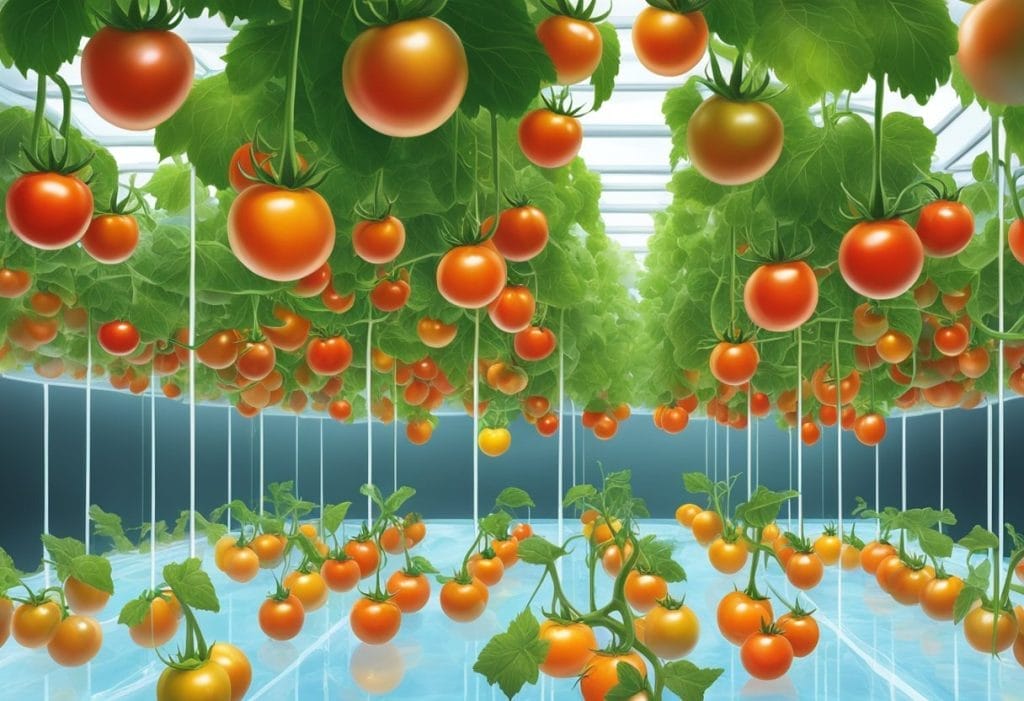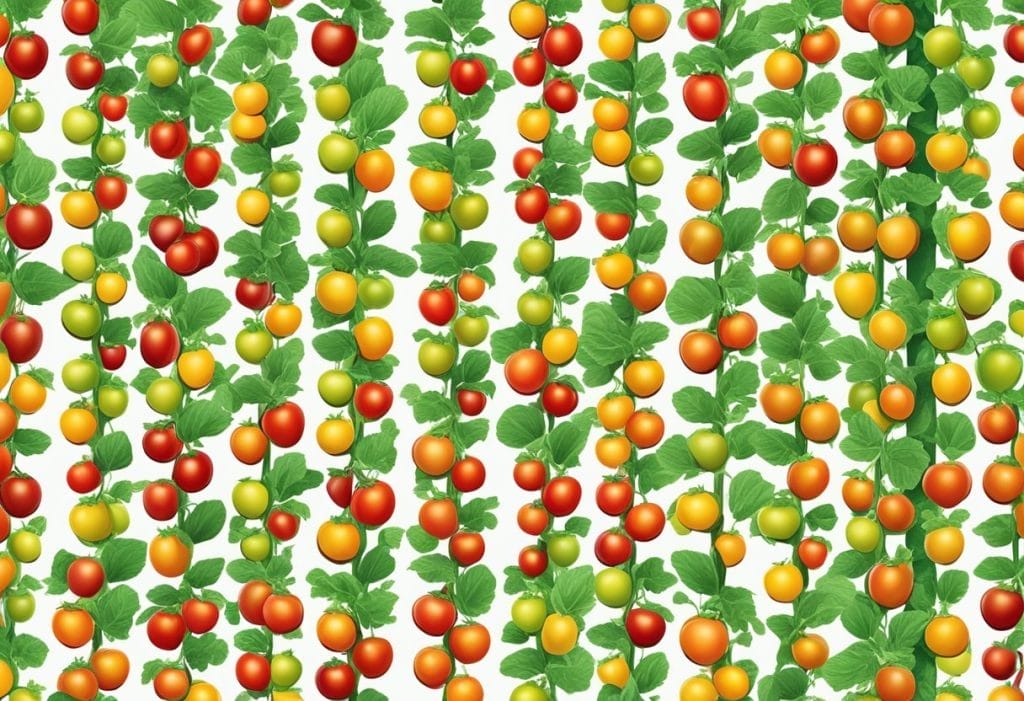Cherry Tomatoes Hydroponic Growing: Best Practices for High Yields
Growing cherry tomatoes using hydroponic systems allows you to cultivate this popular fruit year-round, regardless of outdoor weather conditions. Hydroponics is a method of growing plants without soil, instead using a nutrient-rich water solution.
Cherry tomatoes are particularly well-suited for these systems due to their relatively small size and rapid growth. By opting for hydroponic cultivation, you eliminate the unpredictability of soil quality and outdoor elements, providing a controlled environment that can lead to higher yields and potentially more nutritious fruits.

In a hydroponic setup, you can control every aspect of the growing conditions, from the nutrient mix to the pH and EC (Electrical Conductivity) of the water. This level of control ensures that your cherry tomatoes receive the optimal blend of nutrients and water, directly to their roots, without the competition of weeds or soil-borne pests and diseases. Such precision not only promotes healthy growth but can also impact the flavor profile of your tomatoes, often resulting in sweeter and more flavorful fruits than those grown in traditional garden soil.
Before diving into hydroponic gardening, it’s important to select the right variety of cherry tomato that thrives in a soilless environment. Consider also the type of hydroponic system you wish to use, whether it be a deep water culture, ebb and flow, or a drip system. Each system has its advantages and your choice will depend on factors such as space, budget, and how involved you want to be in the growing process. With the right approach, you’ll find that growing cherry tomatoes hydroponically can be a rewarding and fruitful endeavor.
Fundamentals of Hydroponics

Hydroponics allows you to grow cherry tomatoes without soil, using mineral nutrient solutions in water. This method enhances control over the environmental conditions, providing an optimal growth habitat for your plants’ roots.
Hydroponic Systems
Different hydroponic systems offer unique benefits and functionality. Key types include:
- Nutrient Film Technique (NFT): In this system, a continuous flow of nutrient solution runs over the roots of plants, which are suspended in channels, providing a balance of nutrients, oxygen, and water.
- Deep Water Culture (DWC): Your plants’ roots suspend in a nutrient-rich solution, which is oxygenated to prevent drowning and ensure root health.
- Ebb and Flow: Also known as a flood and drain system, it periodically floods the plant roots with a nutrient solution and then drains back, offering periods of nutrient uptake and oxygen exposure.
- Drip System: It involves dripping nutrient solution onto the growth medium at regular intervals, supplying a steady stream of nutrients to the cherry tomato plants.
Hydroponic Mediums
The growing medium provides support to plant roots in a hydroponic system. Some common mediums include:
- Rockwool: Composed of melted rock spun into fibers, providing an inert and sterile environment for roots.
- Clay Pellets: They have high porosity and air retention capabilities, which benefit root aeration and support.
Nutrient Solutions
Nutrient solutions are vital for hydroponic farming, as they replace the nutrients typically found in soil. When preparing your nutrient solution:
- Macronutrients and Micronutrients: Ensure it contains both macronutrients (Nitrogen, Phosphorous, Potassium) and micronutrients (Iron, Manganese, Boron) vital for plant growth.
- pH Levels: Regular monitoring of the pH level is critical – aim for a pH range of 5.5 to 6.5, which allows optimal nutrient uptake.
- Oxygen Supply: Dissolved oxygen is crucial; without it, roots can suffocate. Oxygenating pumps or air stones often address this need in systems like DWC.
Varieties and Selection

When embarking on the cultivation of hydroponic cherry tomatoes, your success hinges on the specific varieties you select and how you start your seeds. Each cherry tomato cultivar thrives under particular conditions and delivers distinct flavors and growth habits.
Cherry Tomato Varieties
In your hydroponic system, opt for cherry tomato varieties renowned for their adaptability and robustness. Some standout cultivars include:
- ‘Sun Gold’: These deliver a burst of sweetness, with an attractive golden hue.
- ‘Sakura’: Known for its prolific yield, Sakura tomatoes offer a fine balance of sweetness and tomato tang.
- ‘Sweet Million’: A classic, reliable cultivar that produces a high volume of sweet cherry tomatoes ideal for hydroponic growing.
Seed Selection and Germination
To ensure a strong start:
- Source high-quality seeds from reputable suppliers to guarantee genetic purity and high germination rates.
- Employ a sterile seed-starting mix, humidity controls, and consistent temperatures between 65-75°F (18-24°C) for optimal germination.
- Monitor your seedlings, thinning as needed to prevent overcrowding and promote the strongest growth.
Your care in the selection and germination phases sets a solid foundation for thriving hydroponic cherry tomato plants.
Growing Conditions and Management

Creating the ideal environment for hydroponically grown cherry tomatoes involves careful control of various factors that include light, temperature, water, and nutrients. Your focus on these parameters will ensure healthy plant growth and an abundant yield.
Lighting and Temperature Control
Proper lighting is essential for the photosynthesis of your cherry tomatoes, especially when growing indoors. You’ll want to use artificial lighting such as LED grow lights because they provide a full spectrum of light while emitting less heat than other lighting systems.
- Ideal light duration: 16 to 18 hours per day
- Optimal temperature range: 18-25°C (65-77°F) during the day and no lower than 10°C (50°F) at night
Careful monitoring of temperature will prevent heat stress. LED lights contribute minimal heat, making temperature control easier.
Water and Nutrient Management
Your plants require consistent access to water infused with nutrients. The concentration of Nitrogen, Phosphorus, and other essential nutrients has to be balanced correctly to foster healthy growth.
- EC (Electrical Conductivity): Aim for a range between 2.0 to 3.5 mS/cm depending on the growth stage of the plant.
- pH: Maintain a slightly acidic pH level between 5.5 to 6.5 for optimal nutrient uptake.
Recirculating systems allow you to conserve water and precisely manage nutrient levels.
Pollination and Growth Monitoring
In a controlled environment, without natural pollinators like bees, you might need to pollinate your cherry tomatoes manually by gently shaking the plants or using a small brush to transfer pollen.
- Humidity: Keep between 40% to 70% to aid in the pollination process.
- Regular inspection: Check for any signs of nutrient deficiency or disease to maintain steady growth rates.
By managing these conditions effectively, you ensure that your cherry tomatoes have the best chance at health and abundant fruiting in a hydroponic setup.
Pest, Disease, and Deficiency Management
In the hydroponic cultivation of cherry tomatoes, vigilance in preventing pests, managing diseases, and correcting nutrient deficiencies is crucial for healthy plants and maximum yield.

Preventing and Managing Pests
Pests can threaten your hydroponic cherry tomatoes, but with regular monitoring and the right strategies, you can keep them under control. Spider mites, whiteflies, and aphids are among the common pests you might encounter. To manage these effectively:
- Regular Inspections: Check your plants frequently for signs of pest activity.
- Physical Removal: Gently remove pests by hand or with a water spray when populations are small.
- Biological Controls: Introduce beneficial insects that prey on these pests, such as ladybugs for aphids.
- Controlled Environment: Maintain optimal conditions as extreme temperatures and humidity levels can stress plants and attract pests.
Disease Avoidance
Hydroponic systems are not immune to diseases, but the absence of soil reduces the risk of soil-borne diseases like blossom end rot. To maintain disease-free plants:
- Sterilization: Regularly clean and sterilize your system to prevent fungal and bacterial growth.
- Proper Air Circulation: Ensure good air movement to reduce humidity and prevent mildews.
- System Monitoring: Check pH and nutrient levels to deter conditions that favor disease.
Nutrient Deficiencies
Your cherry tomatoes need a balance of micronutrients and macronutrients to thrive. Deficiencies can lead to problems such as yellowing leaves or blossom end rot. To address and prevent nutrient issues:
- Balanced Nutrient Solution: Use a complete nutrient solution designed for hydroponic tomatoes, rich in calcium and magnesium to prevent blossom end rot and chlorosis.
- Regular Testing: Monitor nutrient levels and pH of your solution to ensure plants are receiving what they need.
- Adjustments: Respond to signs of deficiency swiftly by adjusting your nutrient mixture accordingly.
By following these guidelines, you can create a healthy environment that supports robust growth and minimizes issues with pests, diseases, and nutrient deficiencies.
Harvesting and Post-Harvest
Harvesting your hydroponically grown cherry tomatoes at the right time is crucial to optimize both flavor and nutrition. Post-harvest handling is equally important to maintain quality and ensure a longer shelf-life.
Optimal Harvesting Techniques
When your cherry tomatoes reach full color and are firm to the touch, they are ready to harvest. Use the following method for harvesting:
- Gently Twist: Rotate the tomato until it naturally separates from the stem or
- Snip with Scissors: Use a clean pair of scissors or clippers to cut the stem close to the fruit.
Harvesting should be done regularly to encourage continuous production and maintain a higher yield. Tomatoes left too long on the plant can lose flavor and nutritional value.
Post-Harvest Quality Preservation
After harvest, take steps to preserve the post-harvest quality of your cherry tomatoes:
- Temperature Management: Keep tomatoes at 10°C (50°F) to slow down the ripening process and prevent over-ripening.
- Humidity Control: Maintain a relative humidity around 90-95% to keep the tomatoes from drying out and losing their firm texture.
By carefully controlling post-harvest conditions, you contribute to retaining the tomatoes’ high quality, from flavor and nutrition to texture and appearance, thus extending their viability in the market or at home.




